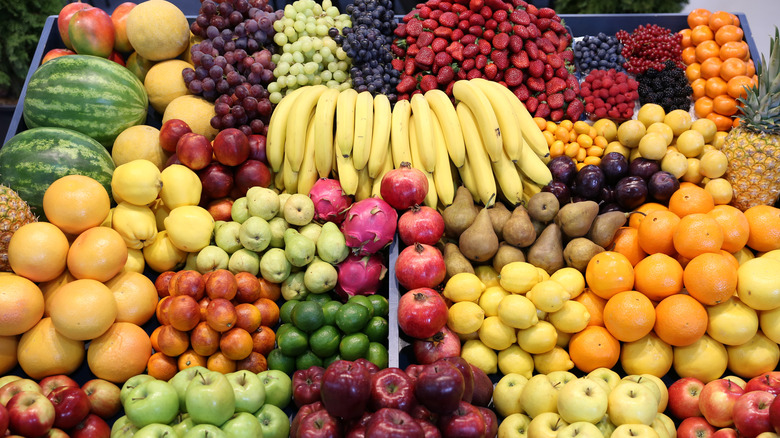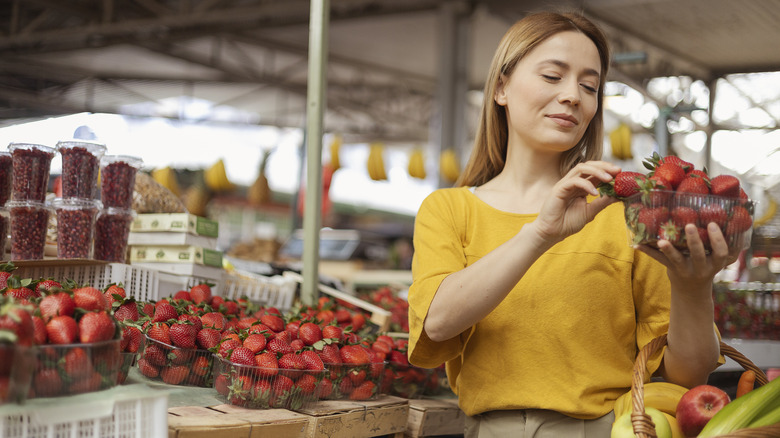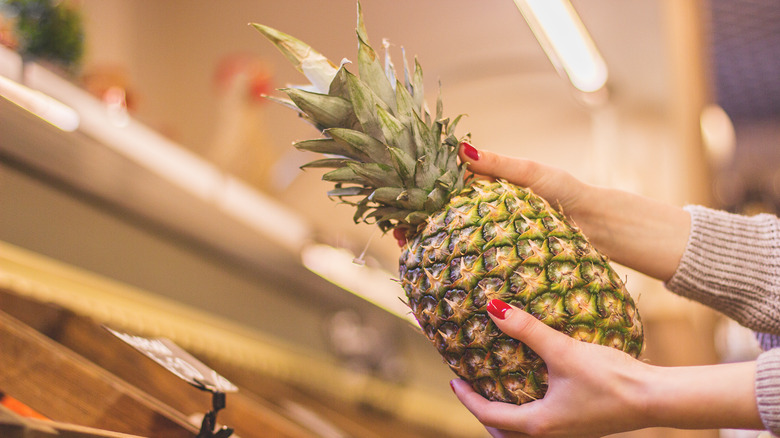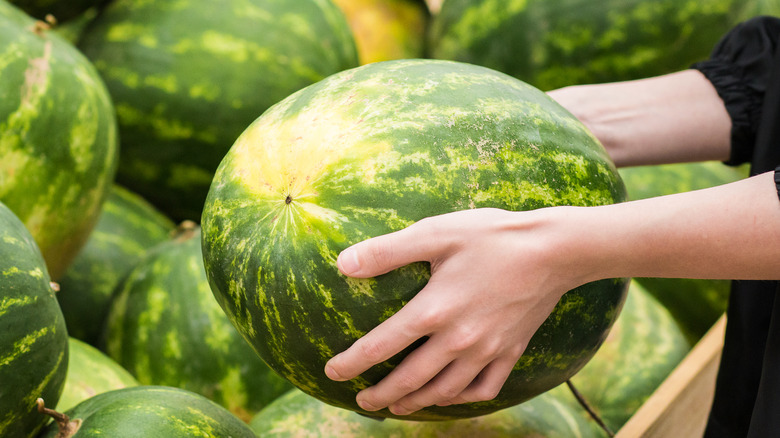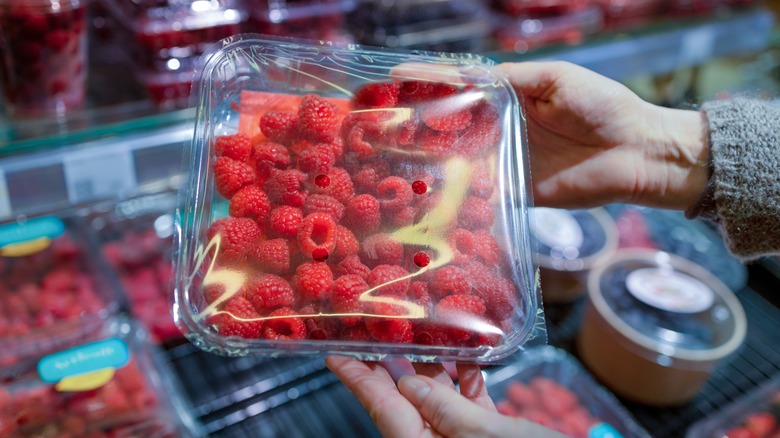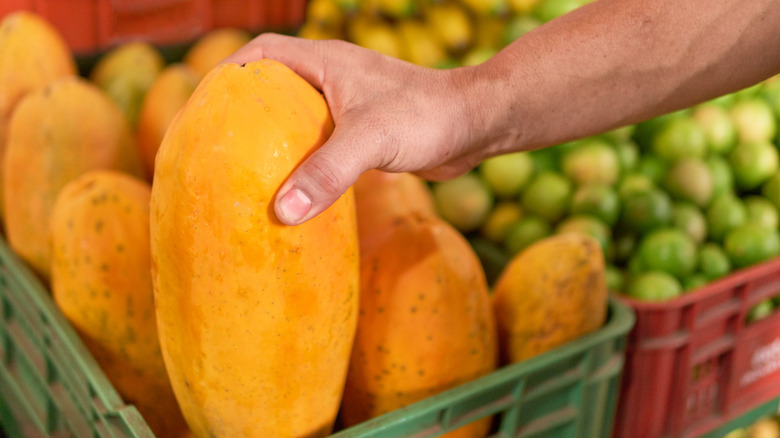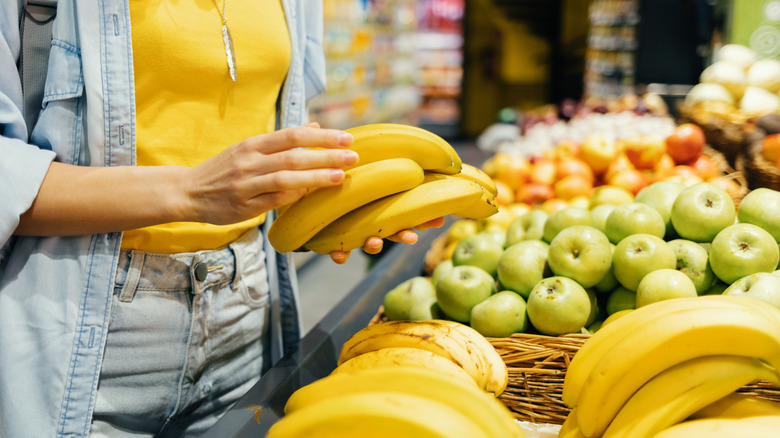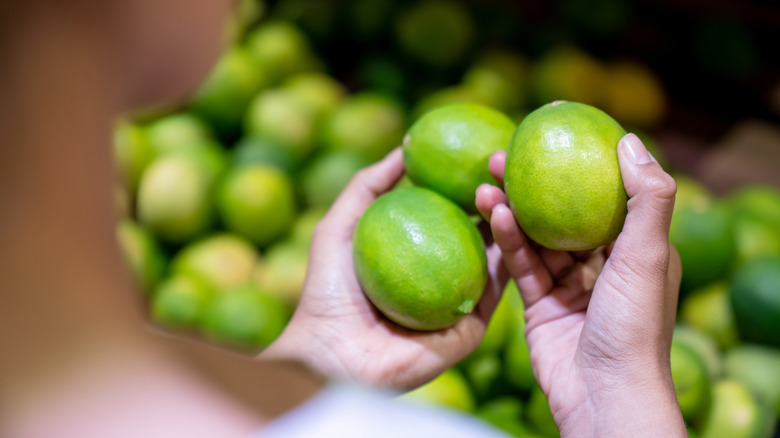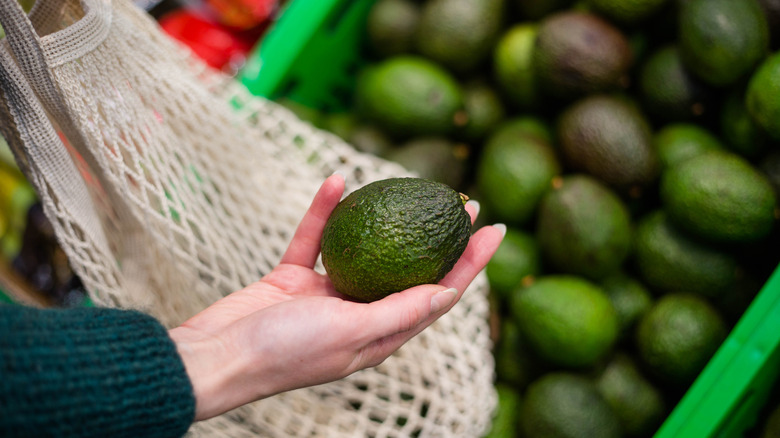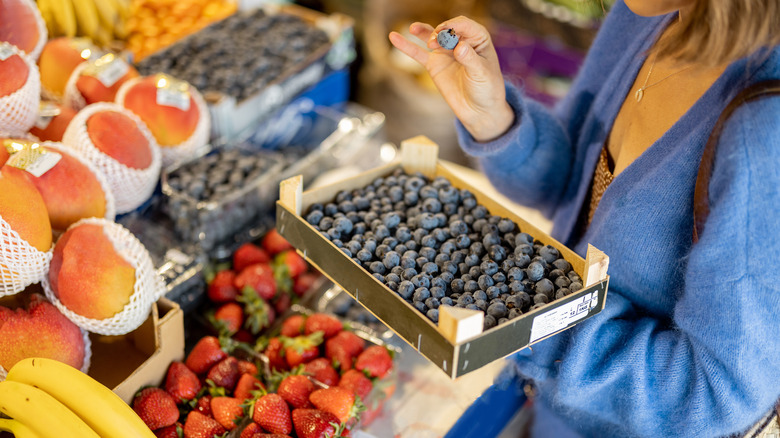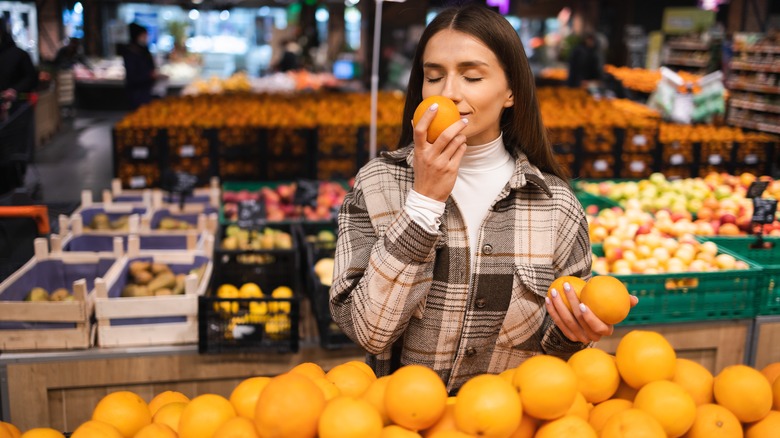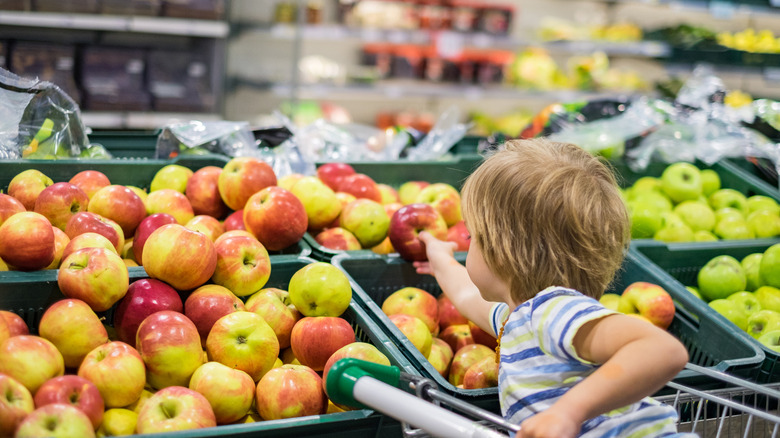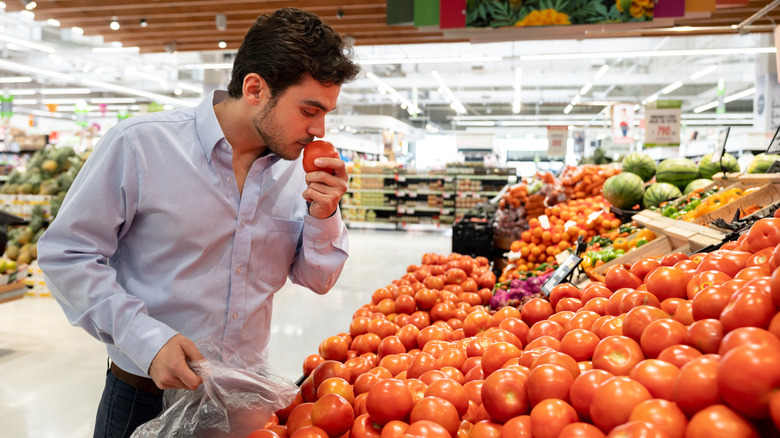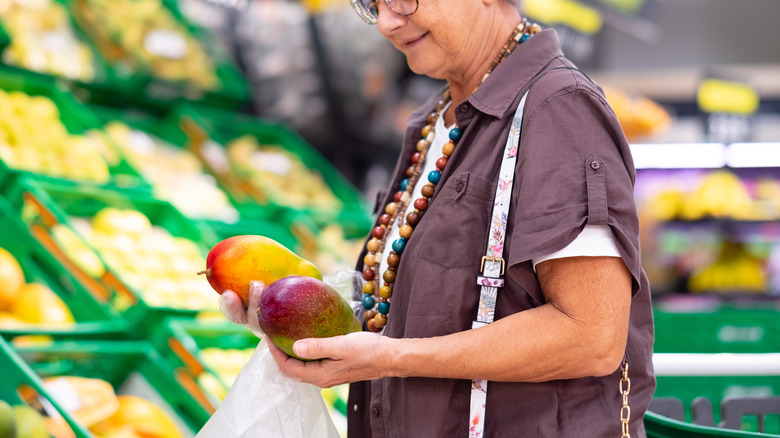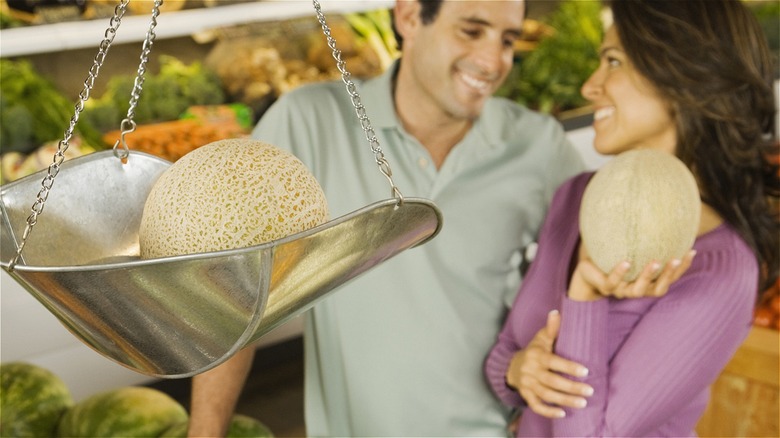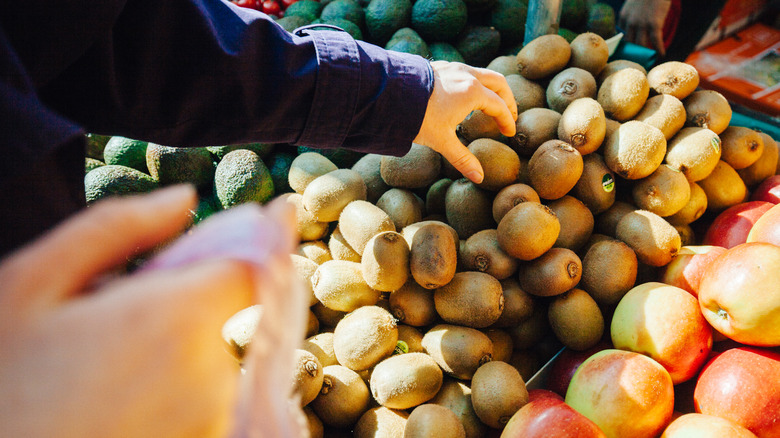How To Pick The Best Watermelon & Other Fruits
At just about any point in the year, you can find a variety of fruits at your local grocery store. Yet we know that certain fruits are a seasonal commodity — perhaps that's why it's so difficult to find the ripest and tastiest fruits during the off-season. We've probably all experienced the bustle of strawberries flooding the shelves and how bare those shelves can become once summer is over. Even though peak season might bring you the best selections, there is a method to pick the best fruit to buy every time.
Between color, texture, scent, and even minor blemishes, nature provides subtle cues to indicate a fruit's readiness. So, whether you're navigating the bustling aisles of a grocery store or perusing a local farmers' market, you'll be equipped to discern the gems from the duds. Here, we'll explore those subtleties and markers so you can know if the fruit you're buying is up to par, or needs to stay buried in the bin at the store.
Strawberries
Selecting strawberries calls for strategic timing — opt for in-season or locally grown varieties for the most flavorful berries. Strawberry season is during spring and early summer, so picking them during those months will provide a sweeter taste compared to off-season berries. This is largely because strawberries are shipped during off-season months and can lose quality during the journey.
There are strawberry varieties you might not be aware of, and a supermarket might not specify which berries you're buying, so it helps to know what to look for. A vibrant, deep red color is your go-to signal of ripeness; avoid pale or partially white strawberries, as they might lack in sweetness. Remember, size isn't everything — smaller strawberries can pack a powerful flavor punch.
As you're picking strawberries to buy, it helps to prioritize color and freshness over size, and steer clear of any bruises, soft spots, or mold growth. A good way to check for any molding or blemishes is to turn the carton over and look at the bottom, where moisture collects. And one of the best ways to see if the fruit is ripe and ready is to smell it — if it smells sweet and like a strawberry you'd want to bite, it's likely a good carton to bring home.
Pineapples
When it comes to selecting a ripe pineapple, there are a couple of key pointers to keep in mind. First, you'll want to examine the pineapple's top leaves — bright green leaves are indicative of the fruit's overall freshness and quality. Specifically, focus on the distinctive top leaves, also called the "fronds," and gently attempt to pluck them from the crown of the pineapple. If they come out with ease, the pineapple is likely ripe; if not, it probably needs more time. After a pineapple is harvested, it doesn't keep ripening, so you won't want to bring home an underripe pineapple in hopes of it reaching its peak.
Second, rely on your sense of touch. Carefully, avoiding the spiky parts, give the pineapple a little squeeze. When pressing the fruit, you should notice firmness with a slight give — this suggests the pineapple is ripe and has a juicy softness inside. When it feels too soft, it's likely overripe, which means not only could it have a bitter taste, but it's well on its way to rotting. Furthermore, if its weight feels heavy, it's likely ripe enough to enjoy. Skin color can vary among pineapple varieties, so prioritizing leaf condition and the fruit's feel is key to selecting a perfect pineapple.
Watermelon
You can follow the 2-finger trick to pick out the best watermelon every time and check for the fruit's ripeness. Holding your index finger and middle finger together, measure the width of the stripes on the rind – it shouldn't be skinnier than your two fingers (a little over an inch). Also, ripe watermelons will have a clear contrast between dark and light stripes, which indicates even growth. Trusting your eyes alone can feel daunting — what if you still bring home an underripe melon?
Additionally, you can examine the bottom of the watermelon. Look for a yellow spot on the bottom, known as the field spot or ground spot. A vibrant yellow spot signifies a longer time on the vine, leading to sweeter and juicier flesh. Its weight will also suggest that it's juicier: More weight means more water, which makes up a watermelon's juiciness. Seeing as how watermelons don't continue ripening after they are taken from the vine, it's imperative to look for signs that show how it was grown and how long it grew for, as that way you're taking home a sweet, juicy melon.
Raspberries
Attention to small details can make all the difference when picking out raspberries. Start by assessing their appearance — the color itself doesn't matter, as raspberries can be red, black, or golden in variety — but vibrant and even coloring is a hallmark of ripeness. Steer clear of berries that look lackluster or faded, as they might not taste as good as brightly colored ones. You'll also want to inspect the plumpness of the berries — the tiny balls that make up the exterior of the berry, called drupelets, should be round and rotund.
Texture is equally important. If possible, give the raspberries a soft press between your fingers; the ideal berry should feel firm with a slight yield. In the store, you'll have to rely on looking closely inside the container. Avoid those that feel, or appear, overly mushy or excessively hard, because they may be souring. Also, opt for raspberries that maintain a consistent shape without any evident deformities or damage. This doesn't mean they need to be perfect in shape, but berries that appear shriveled or excessively dark in color can be a sign of over-ripeness or diminished quality.
Papayas
It can be difficult to gauge a papaya's ripeness in the store, but there are a few tricks to bringing home a delicious one. To begin, focus on the color of its skin. Look for fruits with predominantly orange or yellow skin, and avoid overly green or excessively dark skin. While papayas come in a range of colors from fully green or orange-ish yellow to a splotched combination of the colors, if the skin is too dark or too green, it's likely surpassed its peak ripeness. Size can also be an indicator; for some reason, smaller papayas typically taste better. Another way to make sure you're buying a tasty papaya is to see where it came from — in the U.S., most of the papaya production comes out of the Hawaiian Islands, California, Florida, and Texas.
As with most fruits, you should also use your sense of touch and smell. A gentle press should reveal a slightly soft feel, and a musky scent emanating from the stem end is a telltale sign of ripeness. If the papaya emits a tropical aroma, you're likely holding a delectable fruit; however, a lack of fragrance suggests it might need more time to ripen and develop its sweet flavor. Typically, papayas are harvested and shipped just before they are fully ripe. Since they keep ripening after they're picked, you can buy one that's underripe and wait for it to reach its peak at home.
Bananas
Paying attention to color and quality is key when buying a bundle of bananas. Aim for bananas that are in the mid-ripe stage, which means they should be yellow with a hint of green at the stem. This balance suggests an optimal level of ripeness. As a rule of thumb, green bananas are underripe and more bitter, yellow bananas are ripe and sweet, and brown bananas are overripe — and perfect for baking!
On the flip side, be cautious of bananas that exhibit dark spots on their skin. These often indicate bruising or overripeness, and you won't see it until you peel it. While small brown specks are a natural part of the ripening process and don't necessarily impact the banana's quality, larger dark patches might signify that the bananas are past their prime. Keep in mind that bananas do keep ripening, and at a rather fast rate, so it isn't ideal to buy yellow or yellow-brown bananas unless you're planning to eat them right away.
Limes
When it comes to picking out the best limes from the grocery store, color plays a major role. Pale green limes that are nearly yellow are usually juicier, as despite how we all know limes for their bright green color, the fruit is actually at its ripest when it's yellow. You're likely familiar with two varieties of limes: the popular, average limes and tiny, key limes. Key limes range from light green to yellow, just as regular-sized limes do; however, you'll usually see average limes that are darker green in the store. Even though you'll probably buy these as darker green, they will reach a lighter green color as they ripen, but will become astringent after they are overripe.
Besides color, the feel and weight of limes are also essential when buying this citrus. For the juiciest lime, all varieties should feel heavy for their size. So even though key limes are small, they should have some weight to them. Likewise, all types of limes should be firm and without scratches, blanching, sunburn, or other forms of discoloration.
Avocados
Identifying the ideal avocado hinges on its color, texture, and overall condition. Ripe avocados generally have skin that ranges from deep green to a dark, nearly black hue, depending on the variety. Hass avocados; for instance, tend to be smaller with darker skin, and fuerte avocados — the reigning avocados before Hass avocados took the stores by storm — are usually big and bright green. In general, avocados that are not yet fully ripe typically sport a lighter green shade and bitter taste.
Although there are several avocado varieties you should know about, there are similarities among them when it comes to ripeness. For example, the riper an avocado is, the softer it will feel and the creamier it'll taste. If it is mushy or dented, it's likely past its prime. Avocados ripen quickly, so there's a fine line between bringing it home and eating it. If you're wanting to use it right away, aim for darker, firm avocados with a bit of give, but without blemishes. But if you aren't going to eat it within a couple of days of getting it home, look for avocados that are very firm and lighter in color, and wait for it to peak at home.
Blueberries
Blueberries are called as such for purpose — their blue color is crucial for determining their ripeness. These berries don't keep ripening after they are plucked, so you'll want to avoid blueberries that aren't blue, such as varying shades of white, green, red, or pink, along with the inherent blue, because they'll likely taste sour. The latter color — blueberries tinged with red or pink — suggests they are close to ripe, but not quite there. Ideally, you'll want to pick the bluest of berries or those that are violet. You'll also want to look closely for berries with a bit of white on the skin. It's not mold — it's actually called the "bloom" and it is a sign of proper growth and harvest conditions.
While color matters, size does not. Blueberries can be small or large, but so long as they are plump, they'll be good to eat. Any berries that are shriveled, wrinkled, or mushy should be avoided. And as always, it's wise to check berries for mold before bringing them home. Since they contain a lot of water and moisture, they can easily mold if not stored properly in the store or at home.
Oranges
If you're looking for how to pick out the ripest, juiciest oranges from the store, then feel them out — literally. Before landing on an orange to buy, give it a squeeze. You don't have to apply a lot of pressure, lest it is too soft and you accidentally juice it there in the aisle, but certainly pick it up and grip it. Firm, heavy oranges are best; a hefty orange shows that it's at its prime, bursting with citric, juicy goodness. If it's squishy, it's likely overripe, and if it's lightweight, it's probably not as juicy, or it's underripe.
Aside from pawing at your oranges, you can also smell them. An orange should smell, well, overwhelmingly like an orange. If it smells funky or off-putting at all, you may be dealing with spoiled fruit. Conversely, if you aren't picking up on much smell, it might be underripe or won't taste as citrusy as you'd hope.
Apples
Deciding on which apples to purchase truly comes down to knowing apple varieties. Get to know the most popular apple varieties and their uses, and you'll be better prepared when facing them all in the grocery store. Depending on the variety, apples differ not only in color but also in taste and texture. For instance, Red Delicious and McIntosh apples are grainy and mealy when you take a bite, while Honeycrisp apples are sweet and extra crispy, as their name suggests. It comes down to what texture or flavor you prefer and what you plan to do with the apples. For those who like to eat them straight out of the hand, Granny Smith apples and other firm, crispy varieties are optimal. Mealy apples will break down well, so they have great uses in cooking.
Once you're well-versed in your apple varieties, you can move forward with typical indicators. Generally, you'll want to avoid apples with soft spots or blemishes, a sign of bruising. Check for firmness and glossy skin, but know that color varies among the varieties.
Tomatoes
Whether you're buying tomatoes on the vine or off, locally-grown or in-season tomatoes are likely tastier and fresher than those shipped into a supermarket. These are typically harvested at peak ripeness, maintaining their flavor and texture, sometimes avoiding long-distance transportation altogether. Of the many tips you need to follow when buying tomatoes at the grocery store, remember to use your senses. Smell them, feel them, and scrutinize them.
Tomatoes have an earthy scent unless they're spoiled, which you'll likely detect through your nose. They should be heavyweight and firm with no mushy spots, but a little yield to them. Also, you should focus on the appearance, and look for brightly colored, blemish-free tomatoes. Although the color will differ among different kinds of tomatoes beyond the classic red, from pinks, yellows, greens, and purples to some that are nearly black, take care to avoid ones that are dull or unevenly hued. By checking for blemishes, such as bruises, dark spots, cracks, or wrinkles, you are ensuring that you dodge a rotten tomato.
Mangoes
With mangoes, you won't want to rely solely on color but instead on how it feels when you hold it. If the mango is extra hard and firm, it's not quite ripe, and will have a sharp and bitter taste. Although, this fruit will continue to ripen over the course of a few days. You'll know you have a sweet, ripe, and ready mango if it yields slightly when you squeeze it. Since papayas vary in shape and color, grasping them is truly the best way to examine them before buying.
Like most fruit that keep ripening as the days pass, with mangoes it happens quickly. Mangoes are a good example of fruit that straddles the fine line between ripe and overripe. Because their ripening process is sensitive, it's important to check mangoes frequently once they start to feel soft to avoid missing the optimal window of ripeness, whether in the store or once you have them at home. In spite of that short window, you can hinder the ripening and enjoy a ripe mango a few days later by keeping it cold in your refrigerator.
Cantaloupe
A mix of visual and tactile cues is key when picking a ripe cantaloupe. First, you can gently shake the cantaloupe and listen for a faint rattle or sloshing sound, which could suggest overripeness. A rattling sound can mean the fruit's seed cavity has come loose, which means it's beyond maturity. While this trick is handy, it's not entirely foolproof, so this method should be used alongside other measures for accuracy.
Besides giving it a hearty shake, consider the cantaloupe's weight; it should be heavy and firm with some give when you press the bottom of the melon. Both the heaviness and solid structure are indicative of a ripe, juicy cantaloupe. If it dents when you press it, it's going to be overripe, and if it doesn't yield whatsoever, it's likely not ripe enough. Another easy way to see if a cantaloupe was harvested at the proper time is by checking for its stem. When the melon still has a stem attached, it was harvested earlier than it should've been, which will result in a purely watery flavor instead of a sweet, juicy melon.
Kiwis
As you choose kiwis, consider their robustness, texture, and appearance. Opt for plump kiwis, as it often correlates with their juiciness, and plumpness can be a better indicator of ripeness than sheer size. Assess the kiwi's texture by carefully squeezing it — a ripe kiwi should yield, with a touch of softness. Avoid overly hard kiwis, which might be underripe and tart, as well as excessively mushy ones that could be overripe.
Just like you would with most other fruits, prioritize appearance. Try to veer away from kiwis with wrinkles or soft spots. Wrinkles suggest they've lost some of their water content, which means they've also potentially lost nutrients, and soft spots could signal spoilage. Instead, go for fuzzy, brown, unblemished skin. Keep in mind that kiwis continue to ripen after picking, so slightly firmer ones can mature after a few days on your countertop, and already ripe ones can stay ready to eat if stored in the fridge.
